- 您的位置:
- 标准下载网 >>
- 标准分类 >>
- 商检行业标准(SN) >>
- SN/T 2038-2007 塑料餐具中苯胺和4,4\'-亚甲基二苯胺迁移量的测定 高效液相色谱法
【商检行业标准(SN)】 塑料餐具中苯胺和4,4\'-亚甲基二苯胺迁移量的测定 高效液相色谱法
本网站 发布时间:
2024-06-28 20:38:00
- SN/T2038-2007
- 现行
- 点击下载此标准
标准号:
SN/T 2038-2007
标准名称:
塑料餐具中苯胺和4,4\'-亚甲基二苯胺迁移量的测定 高效液相色谱法
标准类别:
商检行业标准(SN)
标准状态:
现行-
发布日期:
2007-12-24 -
实施日期:
2008-07-01 出版语种:
简体中文下载格式:
.rar.pdf下载大小:
578.44 KB
点击下载
标准简介:
标准下载解压密码:www.bzxz.net
SN/T 2038-2007 塑料餐具中苯胺和4,4\'-亚甲基二苯胺迁移量的测定 高效液相色谱法 SN/T2038-2007
部分标准内容:
中华人民共和国出入境检验检疫行业标准SN/T2038-—2007
塑料餐具中苯胺和4,4'-亚甲基二苯胺迁移量的测定
高效液相色谱法
Determination of aniline and 4,4'-methylenedianilinefrom plastic utensils in food simulants-HPLC/UV2007-12-24发布
中华人民共和国
国家质量监督检验检疫总局
2008-07-01实施
本标准的附录A为规范性附录,附录B为资料性附录。本标准由国家认证认可监督管理委员会提出并归口。本标准由中国检验检疫科学研究院负责起草本标准主要起草人:孙利、陈志锋、国伟、凌云、雍炜、本标准系首次发布的出入境检验检疫行业标准YKANiT KAca
SN/T2038—2007
1范围
塑料餐具中苯胺和4,4-亚甲基二苯胺迁移量的测定高效液相色谱法
SN/T2038—2007
本标准规定了测定塑料餐具中苯胺和4,4'-亚甲基二苯胺特定迁移量的液相色谱方法本标准适用于食品用尼龙餐具中苯胺和4,4-亚甲基二苯胺特定迁移量的测定。2规范性引用文件
下列文件中的条款通过本标准的引用而成为本标准的条款。凡是注日期的引用文件,其随后所有的修改单(不包括勘误的内容)或修订版均不适用于本标准,然而,鼓励根据本标准达成协议的各方研究是否可使用这些文件的最新版本。凡是不注日期的引用文件,其最新版本适用于本标准。GB/T5009.156食品用包装材料及其制品的浸泡试验方法通则82/711/EEC与食品接触的塑料材料和制品中的组分迁移检测的基本规定2002/72/EC委员会关于与食品接触的塑料材料和制品的指令3方法提要
样品经食品模拟物浸泡后,量取一定量的模拟物浸泡液,经固相萃取净化,液相色谱-紫外检测器测定,对塑料餐具中的苯胺和4,4-亚甲基二苯胺迁移量进行外标法定量分析。4试剂与材料
除另有规定外,所有试剂均为分析纯,水为超纯水。4.1乙腈:HPLC级。
4.2甲醇:HPLC级
4.3氢氧化钠溶液:称取8.0g氢氧化钠固体,置于250mL的烧杯中,加人100mL水溶解,得到物质的量浓度为2mol/L氢氧化钠溶液,转移至塑料瓶中储存4.4,氢氧化钠溶液:量取5mL2mol/L氢氧化钠溶液于150mL塑料瓶中,加入95mL水,得到物质的量浓度为0.1mol/L氢氧化钠溶液。4.5乙酸溶液:称取1.2g乙酸于250mL烧杯中,加入200mL水,混匀,得到物质的量浓度为0.1mol/L的乙酸溶液。
4.6苯胺、4.4-亚甲基二苯胺:标准品,纯度>99.0%。4.7固相萃取小柱EnviChromP(6mL,500mg)或相当。4.8食品模拟物:
4.8.1超纯水(模拟物A)。
4.8.23%(质量浓度)乙酸水溶液(模拟物B):称取15.0g(精确到0.1g)乙酸,用水稀释并转移到500mL容量瓶中,水定容至刻度。4.8.315%(体积分数)乙醇水溶液(模拟物C):量取75mL乙醇于500mL容量瓶中,水定容至刻度。4.9标准储备液:称取苯胺和4,4-亚甲基二苯胺各10.0mg(精确到0.1mg)使用甲醇稀释并转移至50mL棕色容量瓶中,甲醇定容至刻度,充分混匀.得到浓度为200mg/L的标准储备液,4℃下避光保存,备用。
SN/T2038—2007
YKAONTKAca
4.10混合标准工作液:准确量取4.9中标准储备液各5.0mL于50mL棕色容量瓶中,甲醇定容至刻度,得到浓度为20mg/L的混合标准工作液,4℃下避光保存,备用。5仪器
5.1液相色谱仪:带紫外检测器。5.2氮吹仪。
5.3固相萃取装置。
5.4振荡器。
5.5注射式样品过滤器(滤膜为0.45μm)。5.6pH计。
5.7恒温烘箱。
6试样预处理
将试样按照浸泡实验需要进行预处理,用清洁剂洗净,自来水冲净,晾干,备用。7分析步骤
7.1浸泡实验
选择餐具与食品接触或可能与食品接触的部分,样品的浸泡方式按照GB/T5009.156进行,模拟物浸泡液体积按照接触面积每平方厘米取2mL模拟液比例选取,样品的浸泡条件按照附录A进行7.2模拟物浸泡液处理方法
7.2.1模拟物A、B:准确量取100mL模拟浸泡液于三角瓶中,使用2mol/L氢氧化钠溶液调节浸泡液pH值至9(pH计测定),使用EnviChromP固相萃取小柱富集,小柱依次使用乙睛、水(pH一7)、水(pH=9)活化后,模拟液经小柱自然流出,流速药为3mL/min,抽干.加人1mL乙睛,抽干,加人5mL乙睛洗脱液,流速约为1mL/min,收集洗脱液.加人0.1mL0.1mol/L的乙酸溶液,经氮吹仪浓缩后,再加入0.1mL0.1mol/L氢氧化钠水溶液,混合溶剂(甲醇:水=1:1)定容至2.0mL,通过0.45μm滤膜过滤至样品瓶中,待上机测定。7.2.2模拟物C:准确量取100mL模拟浸泡液于圆底烧瓶中,加人1mL0.1mol/L的乙酸溶液,充分混匀.通过旋转蒸发仪浓缩至80mL左右,以下操作同7.2.1。7.3标准工作液的配制
使用甲醇逐级稀释4.10中得到的混合标准工作液,得到浓度为0.5mg/L、1.0mg/L、2.0mg/L、5.0mg/L、10.0mg/L混合标准工作液,供高效液相色谱分析测定,获得标准工作曲线,在0.5mg/L~10.0mg/L浓度范围内,其线性相关系数不小于0.999。7.4定量测定
7.4.1仪器参考条件
7.4.1.1色谱柱:ZORBAXBonus-RP,150X4.6mm(内径)5μm或相当者。7.4.1.2流动相A:水;流动相B:甲醇;流动相梯度洗脱条件见表1。表1梯度洗脱条件
时间/min
3流速:0.8mL/min。
7. 4. 1. 3
7.4.1.4检测波长:240nm。
7.4.1.5柱温:30℃。
7.4.1.6进样量:10uL。
7.4.1.7平衡时间:5min。
7.4.2测定
SN/T 2038—2007
分别准确吸取样品待测液(7.2)及标准工作溶液(7.3)10uL注人高效液相色谱仪,使用7.4.1色谱仪器条件进行测定。样品待测液中的苯胺和4,4-亚甲基二苯胺的响应值应与实际应用的标准工作溶液相近并均应在线性范围内。7.4.1高效液相色谱条件下,标准物的色谱图及各组分的参考保留时间参见附录B中图B.1。
7.5空白实验
选择未与样品接触过的模拟物浸泡液按照7.2进行处理,得到的样液按照7.4.1仪器条件进行测定。
8结果计算
各化合物迁移量(mg/kg)按式(1)计算,结算结果应扣除空白值。X=6xcxV
式中:
回收率
化合物迁移量,单位为毫克每千克(mg/kg);标准曲线求得模拟物浸泡液中目标化合物的浓度,单位为毫克每升(mg/L);模拟物浸泡液的总体积,单位为升(L);样品与食品模拟物的接触面积,单位为平方分米(dm);欧盟指令2002/72/EC中规定1mg/kg=6mg/dm。回收率见表2。
表2回收率表
4.4'-亚甲基二苯胺
10测定低限
模拟物浸泡液
水浸泡液
3%乙酸浸泡液
15%乙醇浸泡液
水浸泡液
3%乙酸浸泡液
15%乙醇浸泡液
添加浓度/(mg/kg)
0.01,0.02、0.20
0.01、0.02、0.20
回收率/%
94.0~104.0
92.0~104.2
91.8~102.1
84.0~103.8
86.0~101.0
86.0~101.0
在食品模拟液A、B、C中苯胺和4,4'-亚甲基二苯胺的迁移量的测定低限为0.01mg/kg(1)
SN/T2038—2007
A.1食品模拟物
附录A
(规范性附录)
迁移检测的基本规定
-YYKAONTKAca
由于塑料餐具可能与不同类型食品接触,不可能针对所有可能与之接触的食品开展苯胺和4,4-亚甲基二苯胺迁移量检测,因此引进食品模拟物。食品模拟物通常按照具有一种或多种食品类型特征进行分类。表A,1列出了食品类型和使用的食品模拟物。表A,1食品类型和食品模拟物
食品类型
水性食品(pH>4.5)
酸性食品(pH≤4.5的水性食品)醇类食品
食品模拟物的选择
食品模拟物
蒸馏水或同质水
3%(质量浓度)乙酸
15%(体积分数)乙醇
模拟物 A
模拟物B
模拟物C
表A.2列出了塑料餐具可能接触的各类食品及进行迁移检测时可选用的食品模拟物2在特定情况下检测塑料成型品选用的食品模拟物表A.2
接触食品类型
仅接触水性食品
仅接触酸性食品
仅接触醇类食品
接触所有水性和酸性食品
接触所有水性和醇类食品
接触所有酸性和醇类食品
迁移检测条件(时间和温度)
选取的模拟物
模拟物A
模拟物 B
模拟物 C
模拟物 B
模拟物C
模拟物C和B
选择迁移检测条件须按照塑料餐具在实际使用过程中可预见的与食品接触的最长时间和最高使用温度进行选择,当产品没有明确标注可使用的最高温度和最长接触时间时,模拟物A、B、C的浸泡条件选为100℃/4h。表A.3和表A.4列举了食品模拟物的浸泡时间和温度表A.3
接触时间
5min0.5h1h4h<24h
使用食品模拟物的常规迁移时间检测时间
接触温度
T≤5℃
5℃20℃40℃70℃100℃121℃130℃T>150℃
使用食品模拟物的常规迁移温度检测温度
100℃或回流温度
120℃
130℃
150℃
175℃
该温度对模拟物A,B或C可替换为100℃或回流温度注:附录A所有表格引自欧盟指令82/711/EEC。SN/T2038—2007
SN/T2038—2007
附录B
(资料性附录)
标准品色谱图
4, 1'-亚甲基一莱胺
浓度为0.5mg/L的混合标准液液相色谱图YYKAONTKAca
Forword
SN/T2038—2007
AnnexAisanormativeannexandannexBis aninformativeannexinthisstandardThis standard was proposed by and is under the charge of National Regulatory Commission for Certification and Accreditation
ThisstandardwasdraftedbyChineseacademyof inspectionandquarantineThemain drafters of this standard are Sun Li,Chen Zhifeng.Guo Wei.Ling Yun,Yong Wei,FengNan.
This standard is aEntry-Exit inspection and Quarantine professional standard publishedforthe firsttime.
SN/T2038—2007
-YYKAONTKAca-
Determination of aniline and 4,4'-methylenedianilinefromplasticutensilsinfoodsimulantsHPLC/UVScope
This standard specifies the method for determination of the special migration of aniline and 4,4'methylenedianilinefromplasticutensilsbyHPLC/UV.This standard is applicable to the determination of the special migration of aniline and 4,4'-methyl-enedianilinefromnylonutensils.2 Normative references
These normative references are cited at the appropriate places in the text, and the publications arelisted hereafter.For dated reference,subsequent amendments to or revisions of and of thesepubli-cations apply to this standard only when incorporated in it by amendment or revision.For undatedreferences the latest edition of the publication referred to applies(including amendments).GB/T5009.156General principle for the determination of migration of packagingmaterials and theirproducts
82/711/EEcBasicrulesnecessaryfortestingmigrationof the constituentsofplasticmaterials andarticlesintended to comeinto contactwith foodstuffs2002/72/EC Relating to plastic materials and articles intended to come into contact with foodstuff3Principle
The aqueous simulant test samples are enriched via solid-phase extraction and the resultant solutionare analysed by high performance liquid chromatography with ultraviolet detection using externalstandardmethod.
4Reagents andmaterials
All reagents used are A. R. and\water\is deionized water unless specifically noted4.1
Acetonitrile:HPLC grade
4.2Methanol:HPLCgrade.
SN/T2038—2007
4.3Sodium hydroxide aqueous:Weigh accuratelyabout 8.0 g sodium hydroxide in 250 mL beaker,dissolve with 1oo mL deionized water and store in plastic bottle.The concentration of solutionis2mol/L.
4.4Sodiumhydroxideaqueous:Suck5mLsodiumhydroxideaqueous(4.3)in150mLplasticbot-tle,dilutewith95mLdeionizedwater.Theconcentrationofsolutioniso.1mol/L4.5Acetic acid aqueous:Weigh accurately about 1.2 g acetic acid in 250 mL beaker, dilute with2oomLdeionizedwater.Theconcentrationof solutionis0.1mol/L.4.6Aniline、4,4'-methylenedianiline:Purity>99.0%4.7
Solid-phase extraction tube:Envi Chrom P(6mL,500mg)or the equvilent.4.8Food simulant
Distilledwater(simulantA).4.8.1
4.8.23%(W/V)acetic acidaqueous solution(simulantB):weighaccuratelyabout15.0gaceticacid in 500 mL volumetric flask,dilute and make up to scale with deionized water.4.8.310%(V/V)ethanolaqueoussolution(simulantC):suck50mLethanolin500mLvolumetricflask,diluteandmakeupto scalewithdeionizedwater.4.9 Stock standard solution: weigh accurately about 10.0 mg aniline and 10.0 mg 4,4'-methylene-dianilineandby continuous stirring,dissolvewith methanol in volumetric flask individually.Makeupto50mLwithmethanol.Theconcentrationof solutionis200mg/L,shouldbestoredat4℃ inrefrigerator.
4.10Mixedstandardmiddlesolution:suckseparately5.0mLstockStandardsolution(4.9)intoa5omLvolumetricflask,dilutewithmethanolto scaleandmixwell.Theconcentrationof solutionis20 mg/L,should bestoredat 4℃ in refrigerator.5
Apparatus
5.1Highperformance liquidchromatographywithavariablewavelengthUVdetectorNitrogenevaporator.
Solid-phaseextractiondevice.5.4
SN/T2038—2007
5.5HPLC0.45μmmembranefilters.5.6 pH meter.
Constant temperature oven.免费标准下载网bzxz
Pretreatment
Samples washed with detergent,rinsed with water and dried with air.7Precedure
7.1Immersionmethod
YKAONT KAca-
Samples are immersed in simulants according toGB/T5009.156.Choose the part of material whichcontactwithfoodormaycontactwithfood.Immersionconditionis list inannexA.7.2Preparationoftestsamples
SimulantA、B:Volume100mLsimulant intoconical flask.Thenadd2mol/LNaOHaqueous7.2.1
and make the pH of solvent to 9 by pH meter. Enrich the aniline and 4,4'-methylenedianiline by EnviChrom P SPE cartridge.and wash with acetonitrile,deionized water(pH=7),deionized water(pH=9). Then dry the cartridge. After that wash with 1 mL acetonitrile, dry the cartridge and elutewith 5 mL acetonitrile. Add 0.1 mL 0.1 mol/L acetic acid aqueous to eluant and blow to dryness un-der light nitrogen. Add 0. 1 mL 0. 1 mol/L NaOH aqueous and dilute with mix solvent (methanol :water=1:1)to 2.0 mL.Mix wellby vortex minishaker,filter through 0.45μm membrane andreadyforHPLCdetermination.
Simulant C:Volume100 mL simulant and 1mL0.1mol/L acetic acid aqueous into flask,mixwell and distill to 80 mL by rotary evaporator.The following steps are as same as.7.2.1.7.3Calibrationpreparation
Dilute the mixed standard middle solution andobtain contain approximately0.5mg/L、1.0 mg/L2.0 mg/L、5.0 mg/L、10.0 mg/L to make calibration curve.The correlation is bigger than 0.999whentheconcentrationarebetween0.5mg/L~10.0mg/L.7.4
Determination
7.4.1HPLCoperatingcondition
Column:ZORBAXBouns-RP,150x4.6mm(i.d.),5μmparticlesizeortheequivalent.7.4.1.1
小提示:此标准内容仅展示完整标准里的部分截取内容,若需要完整标准请到上方自行免费下载完整标准文档。
塑料餐具中苯胺和4,4'-亚甲基二苯胺迁移量的测定
高效液相色谱法
Determination of aniline and 4,4'-methylenedianilinefrom plastic utensils in food simulants-HPLC/UV2007-12-24发布
中华人民共和国
国家质量监督检验检疫总局
2008-07-01实施
本标准的附录A为规范性附录,附录B为资料性附录。本标准由国家认证认可监督管理委员会提出并归口。本标准由中国检验检疫科学研究院负责起草本标准主要起草人:孙利、陈志锋、国伟、凌云、雍炜、本标准系首次发布的出入境检验检疫行业标准YKANiT KAca
SN/T2038—2007
1范围
塑料餐具中苯胺和4,4-亚甲基二苯胺迁移量的测定高效液相色谱法
SN/T2038—2007
本标准规定了测定塑料餐具中苯胺和4,4'-亚甲基二苯胺特定迁移量的液相色谱方法本标准适用于食品用尼龙餐具中苯胺和4,4-亚甲基二苯胺特定迁移量的测定。2规范性引用文件
下列文件中的条款通过本标准的引用而成为本标准的条款。凡是注日期的引用文件,其随后所有的修改单(不包括勘误的内容)或修订版均不适用于本标准,然而,鼓励根据本标准达成协议的各方研究是否可使用这些文件的最新版本。凡是不注日期的引用文件,其最新版本适用于本标准。GB/T5009.156食品用包装材料及其制品的浸泡试验方法通则82/711/EEC与食品接触的塑料材料和制品中的组分迁移检测的基本规定2002/72/EC委员会关于与食品接触的塑料材料和制品的指令3方法提要
样品经食品模拟物浸泡后,量取一定量的模拟物浸泡液,经固相萃取净化,液相色谱-紫外检测器测定,对塑料餐具中的苯胺和4,4-亚甲基二苯胺迁移量进行外标法定量分析。4试剂与材料
除另有规定外,所有试剂均为分析纯,水为超纯水。4.1乙腈:HPLC级。
4.2甲醇:HPLC级
4.3氢氧化钠溶液:称取8.0g氢氧化钠固体,置于250mL的烧杯中,加人100mL水溶解,得到物质的量浓度为2mol/L氢氧化钠溶液,转移至塑料瓶中储存4.4,氢氧化钠溶液:量取5mL2mol/L氢氧化钠溶液于150mL塑料瓶中,加入95mL水,得到物质的量浓度为0.1mol/L氢氧化钠溶液。4.5乙酸溶液:称取1.2g乙酸于250mL烧杯中,加入200mL水,混匀,得到物质的量浓度为0.1mol/L的乙酸溶液。
4.6苯胺、4.4-亚甲基二苯胺:标准品,纯度>99.0%。4.7固相萃取小柱EnviChromP(6mL,500mg)或相当。4.8食品模拟物:
4.8.1超纯水(模拟物A)。
4.8.23%(质量浓度)乙酸水溶液(模拟物B):称取15.0g(精确到0.1g)乙酸,用水稀释并转移到500mL容量瓶中,水定容至刻度。4.8.315%(体积分数)乙醇水溶液(模拟物C):量取75mL乙醇于500mL容量瓶中,水定容至刻度。4.9标准储备液:称取苯胺和4,4-亚甲基二苯胺各10.0mg(精确到0.1mg)使用甲醇稀释并转移至50mL棕色容量瓶中,甲醇定容至刻度,充分混匀.得到浓度为200mg/L的标准储备液,4℃下避光保存,备用。
SN/T2038—2007
YKAONTKAca
4.10混合标准工作液:准确量取4.9中标准储备液各5.0mL于50mL棕色容量瓶中,甲醇定容至刻度,得到浓度为20mg/L的混合标准工作液,4℃下避光保存,备用。5仪器
5.1液相色谱仪:带紫外检测器。5.2氮吹仪。
5.3固相萃取装置。
5.4振荡器。
5.5注射式样品过滤器(滤膜为0.45μm)。5.6pH计。
5.7恒温烘箱。
6试样预处理
将试样按照浸泡实验需要进行预处理,用清洁剂洗净,自来水冲净,晾干,备用。7分析步骤
7.1浸泡实验
选择餐具与食品接触或可能与食品接触的部分,样品的浸泡方式按照GB/T5009.156进行,模拟物浸泡液体积按照接触面积每平方厘米取2mL模拟液比例选取,样品的浸泡条件按照附录A进行7.2模拟物浸泡液处理方法
7.2.1模拟物A、B:准确量取100mL模拟浸泡液于三角瓶中,使用2mol/L氢氧化钠溶液调节浸泡液pH值至9(pH计测定),使用EnviChromP固相萃取小柱富集,小柱依次使用乙睛、水(pH一7)、水(pH=9)活化后,模拟液经小柱自然流出,流速药为3mL/min,抽干.加人1mL乙睛,抽干,加人5mL乙睛洗脱液,流速约为1mL/min,收集洗脱液.加人0.1mL0.1mol/L的乙酸溶液,经氮吹仪浓缩后,再加入0.1mL0.1mol/L氢氧化钠水溶液,混合溶剂(甲醇:水=1:1)定容至2.0mL,通过0.45μm滤膜过滤至样品瓶中,待上机测定。7.2.2模拟物C:准确量取100mL模拟浸泡液于圆底烧瓶中,加人1mL0.1mol/L的乙酸溶液,充分混匀.通过旋转蒸发仪浓缩至80mL左右,以下操作同7.2.1。7.3标准工作液的配制
使用甲醇逐级稀释4.10中得到的混合标准工作液,得到浓度为0.5mg/L、1.0mg/L、2.0mg/L、5.0mg/L、10.0mg/L混合标准工作液,供高效液相色谱分析测定,获得标准工作曲线,在0.5mg/L~10.0mg/L浓度范围内,其线性相关系数不小于0.999。7.4定量测定
7.4.1仪器参考条件
7.4.1.1色谱柱:ZORBAXBonus-RP,150X4.6mm(内径)5μm或相当者。7.4.1.2流动相A:水;流动相B:甲醇;流动相梯度洗脱条件见表1。表1梯度洗脱条件
时间/min
3流速:0.8mL/min。
7. 4. 1. 3
7.4.1.4检测波长:240nm。
7.4.1.5柱温:30℃。
7.4.1.6进样量:10uL。
7.4.1.7平衡时间:5min。
7.4.2测定
SN/T 2038—2007
分别准确吸取样品待测液(7.2)及标准工作溶液(7.3)10uL注人高效液相色谱仪,使用7.4.1色谱仪器条件进行测定。样品待测液中的苯胺和4,4-亚甲基二苯胺的响应值应与实际应用的标准工作溶液相近并均应在线性范围内。7.4.1高效液相色谱条件下,标准物的色谱图及各组分的参考保留时间参见附录B中图B.1。
7.5空白实验
选择未与样品接触过的模拟物浸泡液按照7.2进行处理,得到的样液按照7.4.1仪器条件进行测定。
8结果计算
各化合物迁移量(mg/kg)按式(1)计算,结算结果应扣除空白值。X=6xcxV
式中:
回收率
化合物迁移量,单位为毫克每千克(mg/kg);标准曲线求得模拟物浸泡液中目标化合物的浓度,单位为毫克每升(mg/L);模拟物浸泡液的总体积,单位为升(L);样品与食品模拟物的接触面积,单位为平方分米(dm);欧盟指令2002/72/EC中规定1mg/kg=6mg/dm。回收率见表2。
表2回收率表
4.4'-亚甲基二苯胺
10测定低限
模拟物浸泡液
水浸泡液
3%乙酸浸泡液
15%乙醇浸泡液
水浸泡液
3%乙酸浸泡液
15%乙醇浸泡液
添加浓度/(mg/kg)
0.01,0.02、0.20
0.01、0.02、0.20
回收率/%
94.0~104.0
92.0~104.2
91.8~102.1
84.0~103.8
86.0~101.0
86.0~101.0
在食品模拟液A、B、C中苯胺和4,4'-亚甲基二苯胺的迁移量的测定低限为0.01mg/kg(1)
SN/T2038—2007
A.1食品模拟物
附录A
(规范性附录)
迁移检测的基本规定
-YYKAONTKAca
由于塑料餐具可能与不同类型食品接触,不可能针对所有可能与之接触的食品开展苯胺和4,4-亚甲基二苯胺迁移量检测,因此引进食品模拟物。食品模拟物通常按照具有一种或多种食品类型特征进行分类。表A,1列出了食品类型和使用的食品模拟物。表A,1食品类型和食品模拟物
食品类型
水性食品(pH>4.5)
酸性食品(pH≤4.5的水性食品)醇类食品
食品模拟物的选择
食品模拟物
蒸馏水或同质水
3%(质量浓度)乙酸
15%(体积分数)乙醇
模拟物 A
模拟物B
模拟物C
表A.2列出了塑料餐具可能接触的各类食品及进行迁移检测时可选用的食品模拟物2在特定情况下检测塑料成型品选用的食品模拟物表A.2
接触食品类型
仅接触水性食品
仅接触酸性食品
仅接触醇类食品
接触所有水性和酸性食品
接触所有水性和醇类食品
接触所有酸性和醇类食品
迁移检测条件(时间和温度)
选取的模拟物
模拟物A
模拟物 B
模拟物 C
模拟物 B
模拟物C
模拟物C和B
选择迁移检测条件须按照塑料餐具在实际使用过程中可预见的与食品接触的最长时间和最高使用温度进行选择,当产品没有明确标注可使用的最高温度和最长接触时间时,模拟物A、B、C的浸泡条件选为100℃/4h。表A.3和表A.4列举了食品模拟物的浸泡时间和温度表A.3
接触时间
5min
使用食品模拟物的常规迁移时间检测时间
接触温度
T≤5℃
5℃
使用食品模拟物的常规迁移温度检测温度
100℃或回流温度
120℃
130℃
150℃
175℃
该温度对模拟物A,B或C可替换为100℃或回流温度注:附录A所有表格引自欧盟指令82/711/EEC。SN/T2038—2007
SN/T2038—2007
附录B
(资料性附录)
标准品色谱图
4, 1'-亚甲基一莱胺
浓度为0.5mg/L的混合标准液液相色谱图YYKAONTKAca
Forword
SN/T2038—2007
AnnexAisanormativeannexandannexBis aninformativeannexinthisstandardThis standard was proposed by and is under the charge of National Regulatory Commission for Certification and Accreditation
ThisstandardwasdraftedbyChineseacademyof inspectionandquarantineThemain drafters of this standard are Sun Li,Chen Zhifeng.Guo Wei.Ling Yun,Yong Wei,FengNan.
This standard is aEntry-Exit inspection and Quarantine professional standard publishedforthe firsttime.
SN/T2038—2007
-YYKAONTKAca-
Determination of aniline and 4,4'-methylenedianilinefromplasticutensilsinfoodsimulantsHPLC/UVScope
This standard specifies the method for determination of the special migration of aniline and 4,4'methylenedianilinefromplasticutensilsbyHPLC/UV.This standard is applicable to the determination of the special migration of aniline and 4,4'-methyl-enedianilinefromnylonutensils.2 Normative references
These normative references are cited at the appropriate places in the text, and the publications arelisted hereafter.For dated reference,subsequent amendments to or revisions of and of thesepubli-cations apply to this standard only when incorporated in it by amendment or revision.For undatedreferences the latest edition of the publication referred to applies(including amendments).GB/T5009.156General principle for the determination of migration of packagingmaterials and theirproducts
82/711/EEcBasicrulesnecessaryfortestingmigrationof the constituentsofplasticmaterials andarticlesintended to comeinto contactwith foodstuffs2002/72/EC Relating to plastic materials and articles intended to come into contact with foodstuff3Principle
The aqueous simulant test samples are enriched via solid-phase extraction and the resultant solutionare analysed by high performance liquid chromatography with ultraviolet detection using externalstandardmethod.
4Reagents andmaterials
All reagents used are A. R. and\water\is deionized water unless specifically noted4.1
Acetonitrile:HPLC grade
4.2Methanol:HPLCgrade.
SN/T2038—2007
4.3Sodium hydroxide aqueous:Weigh accuratelyabout 8.0 g sodium hydroxide in 250 mL beaker,dissolve with 1oo mL deionized water and store in plastic bottle.The concentration of solutionis2mol/L.
4.4Sodiumhydroxideaqueous:Suck5mLsodiumhydroxideaqueous(4.3)in150mLplasticbot-tle,dilutewith95mLdeionizedwater.Theconcentrationofsolutioniso.1mol/L4.5Acetic acid aqueous:Weigh accurately about 1.2 g acetic acid in 250 mL beaker, dilute with2oomLdeionizedwater.Theconcentrationof solutionis0.1mol/L.4.6Aniline、4,4'-methylenedianiline:Purity>99.0%4.7
Solid-phase extraction tube:Envi Chrom P(6mL,500mg)or the equvilent.4.8Food simulant
Distilledwater(simulantA).4.8.1
4.8.23%(W/V)acetic acidaqueous solution(simulantB):weighaccuratelyabout15.0gaceticacid in 500 mL volumetric flask,dilute and make up to scale with deionized water.4.8.310%(V/V)ethanolaqueoussolution(simulantC):suck50mLethanolin500mLvolumetricflask,diluteandmakeupto scalewithdeionizedwater.4.9 Stock standard solution: weigh accurately about 10.0 mg aniline and 10.0 mg 4,4'-methylene-dianilineandby continuous stirring,dissolvewith methanol in volumetric flask individually.Makeupto50mLwithmethanol.Theconcentrationof solutionis200mg/L,shouldbestoredat4℃ inrefrigerator.
4.10Mixedstandardmiddlesolution:suckseparately5.0mLstockStandardsolution(4.9)intoa5omLvolumetricflask,dilutewithmethanolto scaleandmixwell.Theconcentrationof solutionis20 mg/L,should bestoredat 4℃ in refrigerator.5
Apparatus
5.1Highperformance liquidchromatographywithavariablewavelengthUVdetectorNitrogenevaporator.
Solid-phaseextractiondevice.5.4
SN/T2038—2007
5.5HPLC0.45μmmembranefilters.5.6 pH meter.
Constant temperature oven.免费标准下载网bzxz
Pretreatment
Samples washed with detergent,rinsed with water and dried with air.7Precedure
7.1Immersionmethod
YKAONT KAca-
Samples are immersed in simulants according toGB/T5009.156.Choose the part of material whichcontactwithfoodormaycontactwithfood.Immersionconditionis list inannexA.7.2Preparationoftestsamples
SimulantA、B:Volume100mLsimulant intoconical flask.Thenadd2mol/LNaOHaqueous7.2.1
and make the pH of solvent to 9 by pH meter. Enrich the aniline and 4,4'-methylenedianiline by EnviChrom P SPE cartridge.and wash with acetonitrile,deionized water(pH=7),deionized water(pH=9). Then dry the cartridge. After that wash with 1 mL acetonitrile, dry the cartridge and elutewith 5 mL acetonitrile. Add 0.1 mL 0.1 mol/L acetic acid aqueous to eluant and blow to dryness un-der light nitrogen. Add 0. 1 mL 0. 1 mol/L NaOH aqueous and dilute with mix solvent (methanol :water=1:1)to 2.0 mL.Mix wellby vortex minishaker,filter through 0.45μm membrane andreadyforHPLCdetermination.
Simulant C:Volume100 mL simulant and 1mL0.1mol/L acetic acid aqueous into flask,mixwell and distill to 80 mL by rotary evaporator.The following steps are as same as.7.2.1.7.3Calibrationpreparation
Dilute the mixed standard middle solution andobtain contain approximately0.5mg/L、1.0 mg/L2.0 mg/L、5.0 mg/L、10.0 mg/L to make calibration curve.The correlation is bigger than 0.999whentheconcentrationarebetween0.5mg/L~10.0mg/L.7.4
Determination
7.4.1HPLCoperatingcondition
Column:ZORBAXBouns-RP,150x4.6mm(i.d.),5μmparticlesizeortheequivalent.7.4.1.1
小提示:此标准内容仅展示完整标准里的部分截取内容,若需要完整标准请到上方自行免费下载完整标准文档。
标准图片预览:
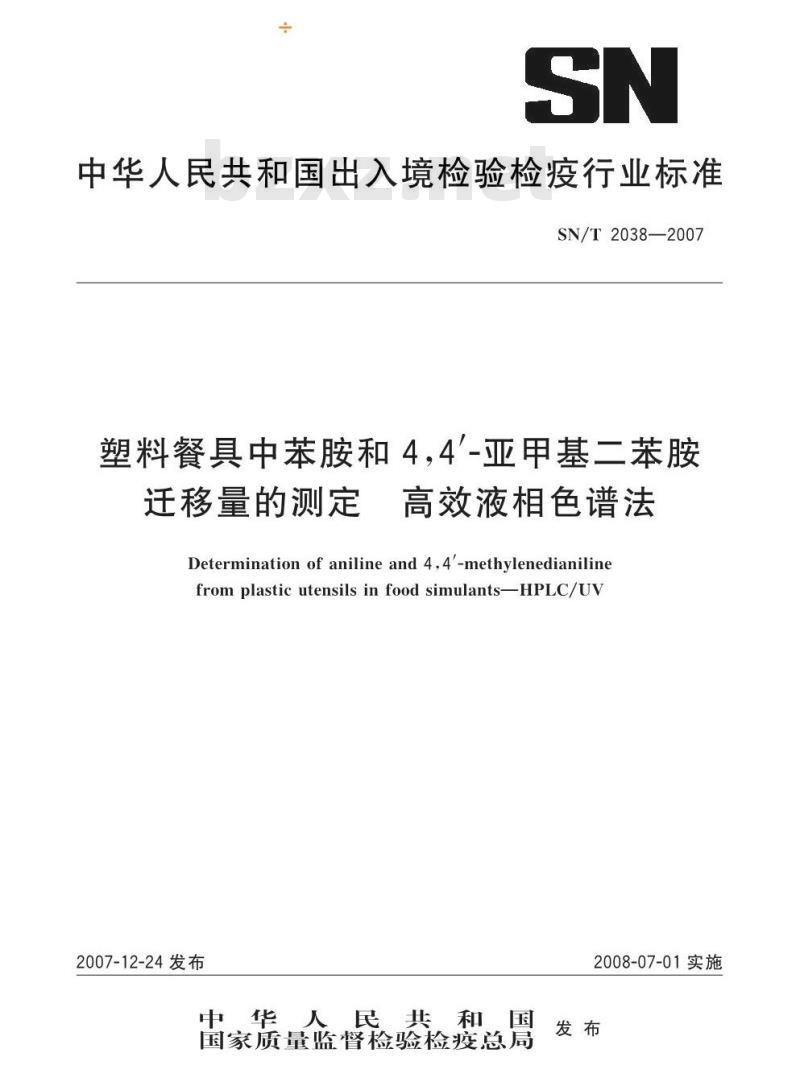
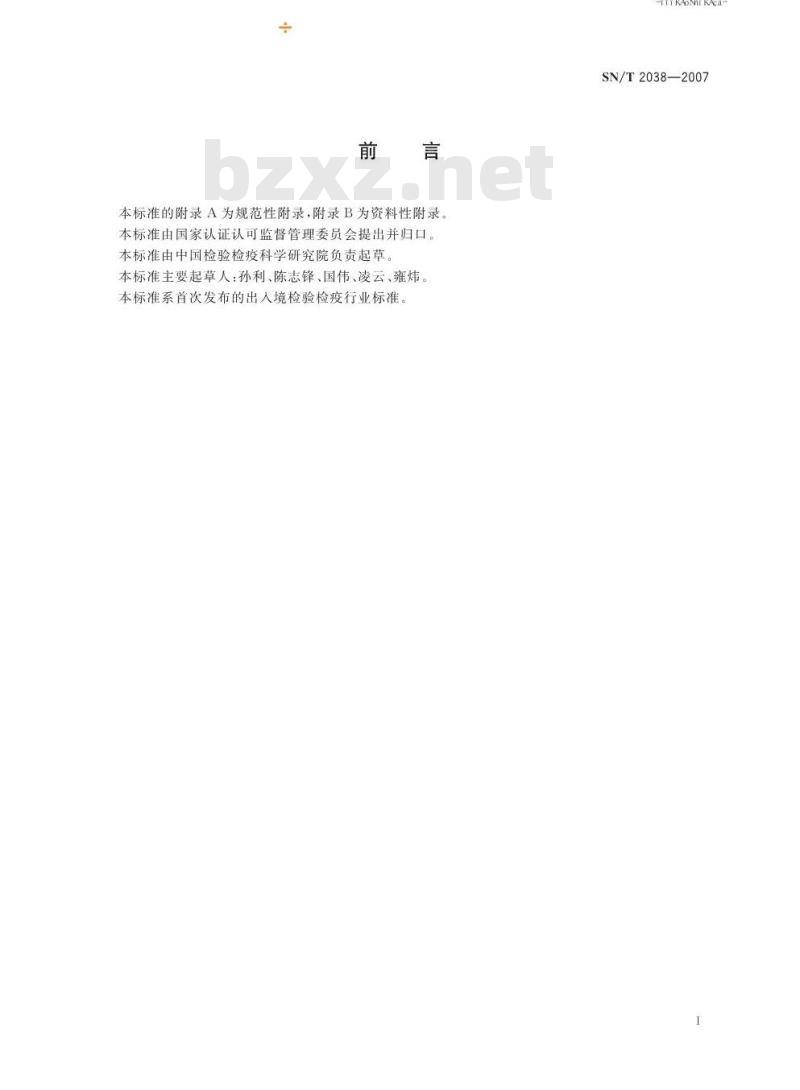
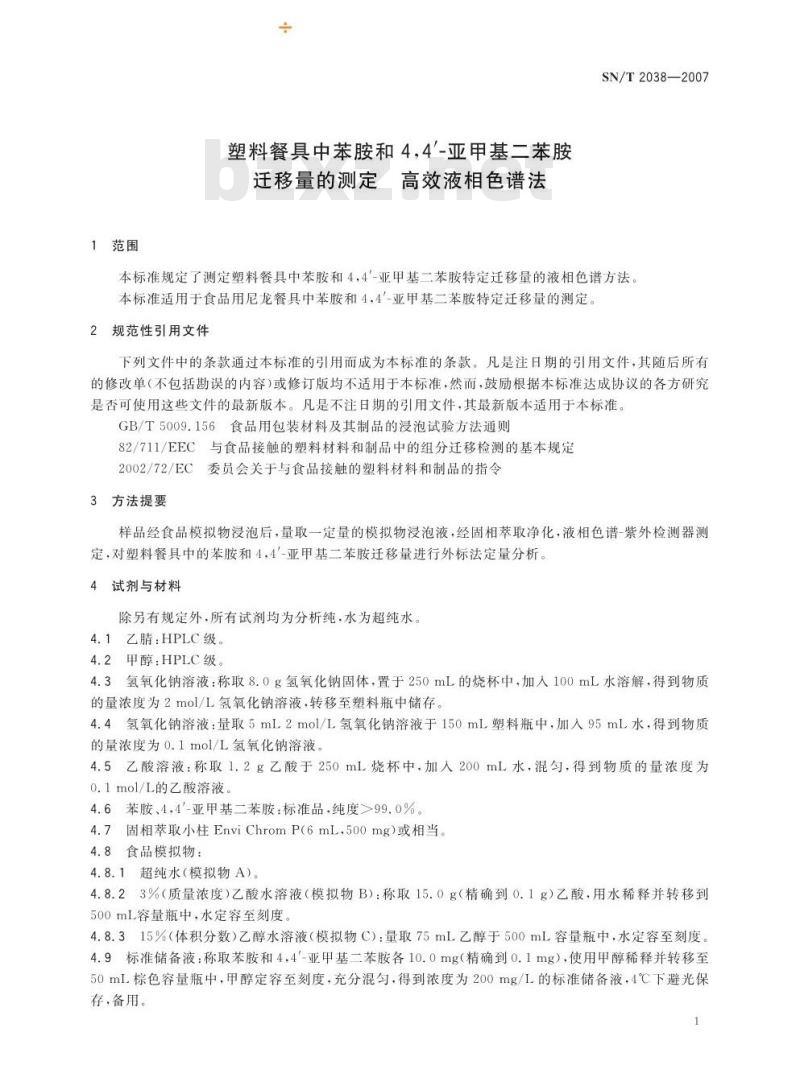
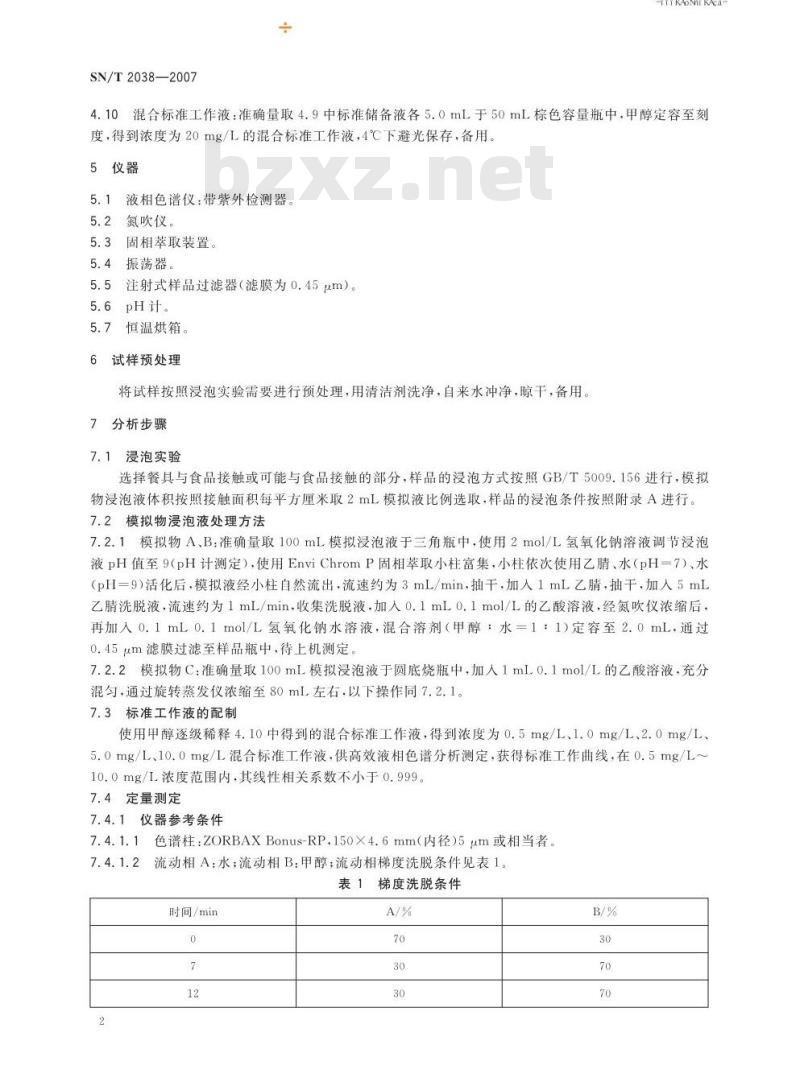
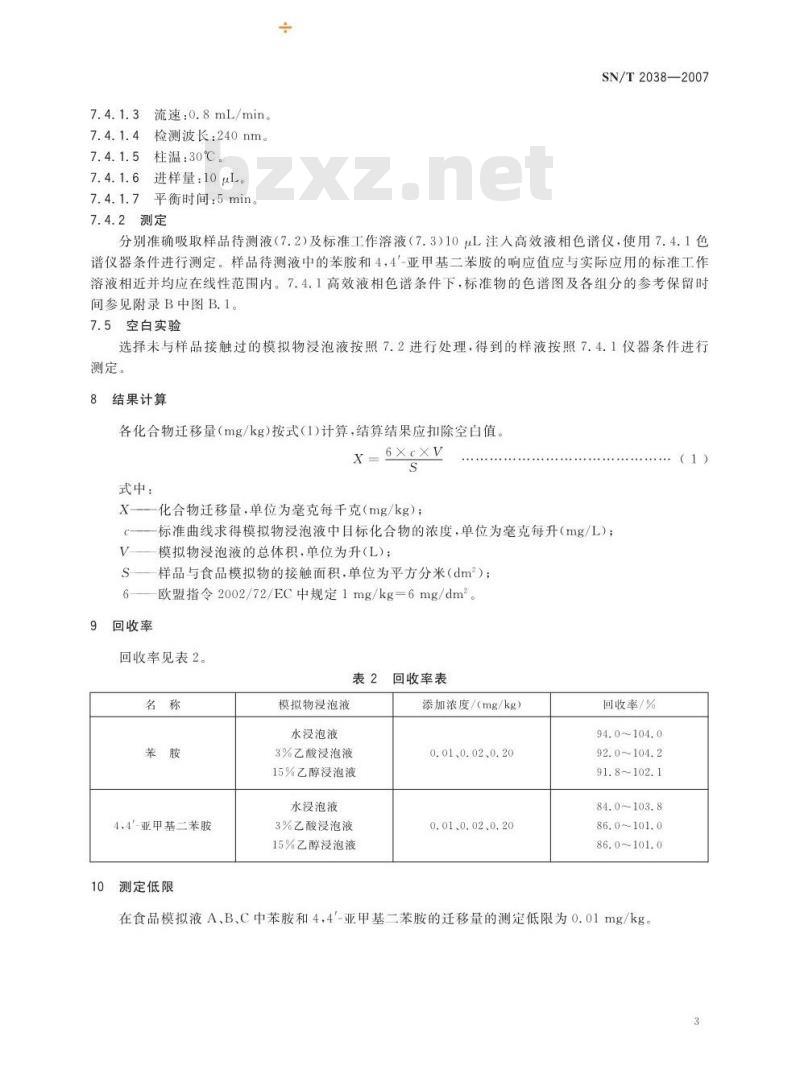
- 热门标准
- 商检行业标准(SN)
- SN/T1509-2005 异尖线虫病诊断规程
- SN/T4569-2016 生物柴油中甲醇、乙醇、正丙醇、异丙醇、正丁醇、异丁醇、叔丁醇及仲丁醇的测定气相色谱法
- SN/T1672.7-2013 进出口医用设备检验规程 第7部分:医用内窥镜
- SN0020-92 出口磁带收录音机安全要求检验规程
- SN0665-1997 出口肉及肉制品中雌三醇残留量检验方法放射免疫法
- SN/T0226.2-1993 出口冻公鱼检验规程
- SN/T0380-1995 出口活鱼检验规程
- SN/T1359.2-2004 进口纺织机械检验规程 织袜机
- SN/T1891.6-2007 进出口微波食品包装容器及包装材料卫生标准 第6部分:玻璃制品
- SN/T1395.2-2005 禽衣原体病琼脂免疫扩散试验操作规程
- SN/T3719.1-2013 进出口纺织行业成套设备检验技术要求 第1部分化纤设备
- SN/T0328-94 出口氟石中氟化钙的化学分析方法
- SN/T3455-2012 植检标准样品评价通用要求
- SN/T2374-2009 绿僵菌、白僵菌生物农药检验操作规程
- SN/T1657.12-2014 进出口电动工具检验规程 第12部分:可移式圆锯
- 行业新闻
请牢记:“bzxz.net”即是“标准下载”四个汉字汉语拼音首字母与国际顶级域名“.net”的组合。 ©2025 标准下载网 www.bzxz.net 本站邮件:bzxznet@163.com
网站备案号:湘ICP备2025141790号-2
网站备案号:湘ICP备2025141790号-2